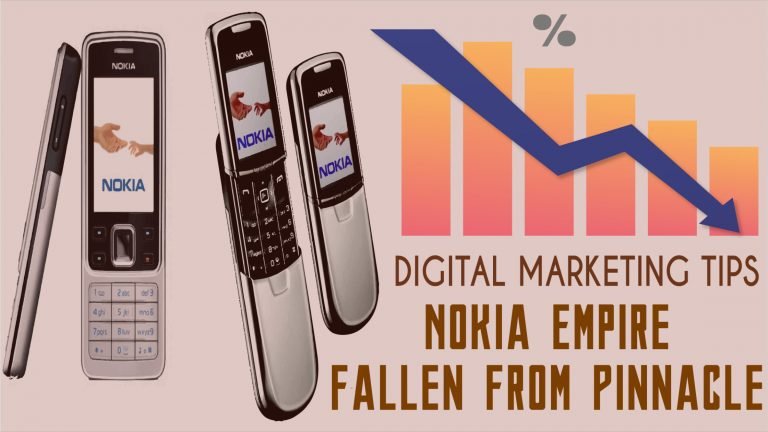Today’s smartphone market or mobile market is filled with many brands like SAMSUNG, Xiaomi, Apple, Oppo, VIVO, etc. But, if we go back a few years, then all of us will be amazed to know that in 2010 or before 2010, the mobile market saw one of the biggest & greatest empires to rule the market, which is Nokia.
Between 2005-2010, Nokia captured almost 80% of the mobile market & their manufactured mobile set was in the top 20 best-selling mobile phones set in a year. They were on the verge of becoming a mammoth of the mobile market.
Coming to the present situation, Nokia is almost out of the market & they are tingling like a lamp now. But what happened to this company so that a company that would be a mammoth ended up being a tingling company just after 10 or 15 years.
Let know about the story of Nokia. A case study that helps incoming entrepreneurs identify their business risks & forecasting about their business. This blog focuses on why Nokia failed after enjoying unrivalled dominance in the mobile segment for several years.
About Nokia

Before we even heard about primitive smartphones, Nokia was already in the marketplace. For a generation, Nokia was in the marketplace, and now and then, they launched new variants of its phone. By offering varied pricing categories, it responded to the needs of various sectors of society. Millennials could feel more connected with the scenario.
Nokia seems to be a Finnish multinational corporation established in 1865 mainly as a pulp mill that later diversified further into the rubber goods sector until embarking on the cellular phone industry. The corporation has become one of the world’s leading providers of mobile phones.
Throughout the initial periods of its existence, Nokia was considered one of the most successful mobile phone companies. Nokia was indeed the world’s leading mobile phone manufacturer in October of 1998.
Nokia embodies the state of the Finnish manufacturing sector in the IT segment. Nokia could get a foothold in the mobile industry due to several kinds of Nokia mobile devices.
Back in the glory days, while Motorola became known as the “mobile gangster,” Nokia announced a new design with clearer audio, a sophisticated look, and a big screen with moving text menus. Simultaneously, the term “Nokia” was recognized across the globe.
Related: Triadic Closure Property- Key to Facebook Success
Success of Nokia

Nokia was first successful because of its youthful, consolidated, and energizing executive committee, who made futuristic and gutsy management decisions tailored to influence the firm’s pioneering technologies as broadband liberalization and digitization of telecommunications infrastructure swiftly spread throughout Europe.
In the mid-1990s, Nokia was at risk of suffering a near-collapse due to the fact that its distribution network was faltering. As a result, Nokia established highly regimented systems and procedures, enabling it to grow considerably more efficiently and more rapidly than its rivals.
Nokia launched their GSM cell phone, the Nokia 1011, in 1992. From 1992 to 1996, the 6110 series through which they drew its long-lasting battery goodness for that whole time. In 1998, the world’s first metallic textured mobile phone was released, the N8810.
Motorola had the leading position in the manufacture of mobile phones. However, the Nokia mobile phone manufacturing output amount was a billion units above Motorola. As a result, Nokia had become the world’s largest mobile phone vendor.
This development came into life through one of the most sold mobile phones, often referred to as Nokia 5100, resulting from new phone manufacturing tools becoming an eye-catching, stylish product. The other noteworthy thing is that Nokia released the first phone that included games, the very first phone to integrate WAP, and the world’s first sliding mobile, all at the same time.
Until 2002, Nokia launched the 7650, the first color display mobile phone, the very first smartphone, and the very first cellphone with a camera. The Nokia N90, N91, and N70 all used the Symbian S60 operating system, and all three phones were successful in the industry.
In 2006, Nokia achieved its pinnacle, as, at the same time, Nokia released models that included the 6030, 5200, N73, N72, N93, N95, E60, and the E50. A year later, Nokia launched the first sliding phone with a side display. The Nokia N8 featuring 12 million pixels was launched in 2010.
Nokia Mobile Phones saw its workforce jump 150% to 27,353 from 1996 to 2000, with sales increasing 503% during the same time. In 2007, 50% of the market was controlled by mobile phones.
For approximately 14 years throughout the mid-1990s, a single firm dominated the mobile phone industry in the developing market. In 1995, Nokia employed over 18,000 workers in Finland, including a substantial number of employees outside of Finland.
Falling of Nokia Empire

After 2010, Nokia began to decline. In February 2012, Nokia joined forces with Microsoft to produce windows mobile. This phone is of critical importance to Nokia, in the same way that Windows is to Microsoft.
Looking at Nokia’s shares, it appears that Nokia can’t go back to any of those former glory days. They eventually withdraw from many locations.
With that knowledge in mind, Nokia understands that they might no longer be the number one mobile handset merchant; therefore, they must safeguard them from being impacted by other smartphone producers.
Nokia’s fast expansion came at a price. This added up to be an increase in management brief work intensification, which hindered the ability of Nokia’s major development centers to devote money and effort to innovations.
For all intents and purposes, Nokia Corporation’s market share fell from 50% to less than 5% during 2013. This was when everyone involved, from the management team to stockholders, even the customers, all feared that Nokia could go bankrupt.
Related: Razorblade model- A Business Strategy Which is Must Known for Entrepreneurs
Reasons for Nokia’s Downfall
In 1998, Nokia was the world’s biggest mobile phone manufacturer. Overtaking Motorola was a difficult task, but Nokia pulled it off. So, in the event, everything worked as it should, what precisely occurred? It was due to a multitude of factors, not a single one of which was most important. Let’s dig deeper and look at the many contributing elements that led to the downfall of one of the 1990s’ biggest smartphone manufacturers.
Resistance To Smartphone Evolution

Cell phone industry development was fast. With the shift to a smartphone, conventional phones altered, but Nokia remained the same. In comparison, it was the one who set the foundation for initial smartphones.
During the year 2002, the business found it difficult to keep up with the speed of technological change. So, Nokia assumed they could get away with simply slapping a touchscreen interface just on the existing system since the Symbian OS was not developed for touchscreen phones, so it didn’t go as planned. Nokia collapsed because of it.
In 2008, after Android was released, Nokia committed a significant error and became the initial seed for its demise. While others jumped on the Android bandwagon, Nokia missed the opportunity.
Nokia refused to modernize, even while phone makers spent all their time upgrading and developing their devices.
To meet customers’ needs, Samsung quickly introduced Android-based smartphones that were reasonably priced and very user-friendly. Nokia management anticipated that touch-sensitive smartphones would not be accepted. Indeed, the qwerty keyboard configuration would remain popular. Its demise was because it was fundamentally wrong about itself.
In short, Nokia did not take into account Android upgrades. Therefore it had no interest in implementing the Android OS. Once it became clear in the market that Nokia saw it exactly wrong, the company released its Symbian operating system.
Apple and Samsung were already well entrenched in their positions. However, it was beyond difficult for either to make a change. Its Symbian operating system had a tough time breaking into the market. People started to turn their backs on Nokia because of this.
The Acquisition of Microsoft

Microsoft’s partnership with Nokia also had a part in Nokia’s downfall. Microsoft was going through hardships at that moment when the business was transferred to it. Nokia’s sales rang the death knell for the company’s independence.
Apple and Samsung, however, were advancing their innovations and technological capabilities at the same time. Nokia had already failed to keep up with the ever-changing market dynamics by the time it decided to react.
One of the greatest mistakes in the IT industry was Microsoft’s purchase of Nokia, which ended up having a waste of time and money for both parties. Many individuals still purchased Nokia devices as recently as 2013.
It was a terrible sight to witness how much the once-great business had declined in 2013, and it was even worse to learn how cheaply they had sold off their phone manufacturing section to Microsoft for next to nothing. Nokia disappeared from the mobile market due to another misstep.
Nokia ultimately received a price of just $6 billion, although it was worth $9.3 billion in 2012. According to the valuation in late 2009, Skype was only worth around 2.75 billion USD, and Microsoft paid $8.5 billion only for business.
Lack of Proper Business Planning

The usual reasons for startup failure include poor strategy and, unfortunately, the same can be said of Nokia. The firm used a technique of umbrella branding that ultimately failed.
As time went on, the confidence the user had in Nokia diminished. The company’s sales and distribution techniques were inefficient. Seeing the disaster, Nokia was motivated to develop physical and logical breakthroughs far out of the ordinary.
But, they had previously been launched by the competition and did not have Nokia’s distinctive style. The Nokia company was eliminated because of issues with its marketing and distribution methods.
In this case, both Samsung and Apple took full advantage of the brilliant game plan that Nokia was unable to grasp. The iPhone and the Samsung Galaxy are flagships products for the two companies. A new edition of these items is released each year with improved functionality.
Because consumers of these companies and future buyers keep a close eye on new releases long before entering the market. They both know when it is about to happen. According to this theory, these build-up expectations about the release of new goods, accompanied by a host of new features, result in an increase in the consumer’s interest in the matter.
Even if the smartphone industry has grown saturated, the launch of a new phone nevertheless generates enthusiasm among the public. But with Nokia, the opposite occurred: this allowed Nokia to go bankrupt.
Lack of Innovations

Nokia’s struggles stemmed from the lack of development through its products. While other manufacturers released more sophisticated smartphones each year, Nokia was late to the market with exposed phones.
Even introducing the Nokia Lumia line didn’t have much of an impact due to a lack of new ideas. The lackluster features had little effect. While 4G networks are more prevalent, Nokia did not even offer 3G phones before 4G was a thing. Despite producing the Asha line, Nokia was already on its way out.
Generally, the mobile phone feature set at the point of penetration throughout the lifespan of the mobile phone mainly was the same, with only slight differences related to use for business communications. The primary reason Nokia did not deal with the challenge was that it was felt there was no need to do so.
The business faced the choice of innovation or expansion finance due to its excessive growth during the previous years. To realize such an innovative or ground-breaking idea, the department which does research and development in the business had virtually no resources, which is why the launch of the newest cell phones was nearly impossible. That’s how Nokia demises year by year.
Related: লিডারশীপ ডেভেলপ করার ৫টি স্টেপ
End Note
Did you know that one of the reasons for Nokia’s downfall is not keeping updated with the world’s innovation?
In this article, we explained why & how, despite having vast growth & being on the verge of becoming mammoth, Nokia demises in a few years of reign in the mobile phone world.
If you want to learn more about how Nokia demises & how you can avoid those mistakes in your business, enroll in our Digital Marketing Course today!
With one of our courses, not only will you become a better marketer but an expert on human behavior too. We offer classes that show you how people think and why they do what they do when it comes to your products or services.
And guess what? You don’t need any previous experience with design tools like Photoshop or Illustrator. Just bring along a laptop with WiFi access, some time for class-related assignments, and your eagerness to learn something new!
There are still a few seats left for the next session, so don’t wait too long before signing up. We hope you enjoyed reading this blog post and learned something new from it.
Click below to enroll yourself in the course.






































